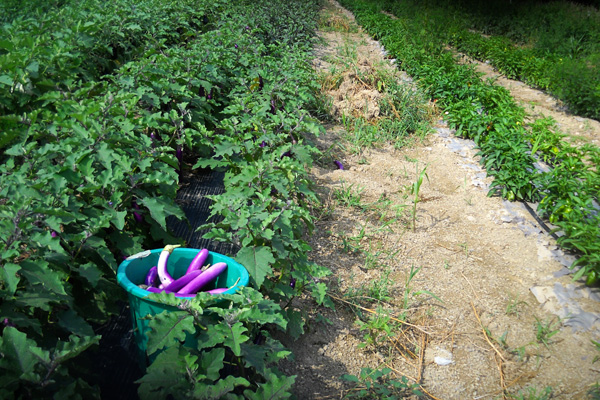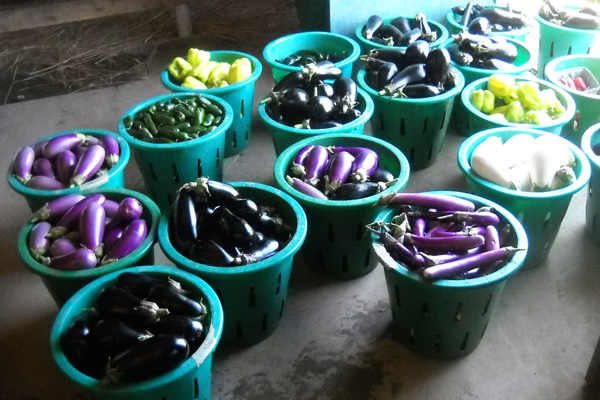-

Erin Donahue -

Christina Barkanic -

Brittany Trott -

Emily Wiley -

Jessica Reilley -

Chris Raines -

Will Nichols -

Emily Reddy -

Michele Marchetti -

Michele Frank -

James Gherardi -

Kit Henshaw -

Christina and Erin -

Kim Tait -

Erin McKinney -

Steve Spanelli -

Sam Komlenic -

Katherine Taylor Grofic -

James Eisenstein -

Jamie Oberdick -

Anna Lombardo -

LacCreta Holland -

Tony Ricci -

Local Food Journey -

Laura Young -

Kristin Camplese -

Harrison's Fresh + Local -

Danielle Matalonis -

Kristine A. -

Linda Weaver -

Naomi Elle Schwartz -

Dana Stuchul -

Cara McShane -

Brittany Smith -

Jessica Illuzzi - Frosty
-

Jessica Paholsky -

James Sechrengost -

Brad Yeckley -

Maya Althouse -

Jordan Reabold -

Kim Chase -

Maria Bryant - Alexandrea Scott
Harvesting Eggplant
Posted by James Eisenstein on 08/08, 2012 at 12:41 PM

The first Basket of Asian Lavender Eggplant. Photo Credit James Eisenstein.
Many Americans have lost touch with the land and food production, and know little about what the folks who grow vegetables actually do. A student of mine on a class visit to a farm was amazed when she pulled a carrot out of the ground. So this is where they come from!
People around here often either grew up on a farm or have gardens, and know how carrots grow. Still, I suspect few know the details of growing less common vegetables. Today’s discussion reveals the shocking truth about life in the eggplant patch at harvest.
Eggplants like it hot, so they need a good start if they are to be harvested in August. There is nothing out of the ordinary about seeding and transplanting. But if eggplants like it hot, flea beetles like eggplant seedlings and young plants even more.
Flea beetles are little black insects that hop away just as you are about to pick them off an eggplant (or radish or kale plant—the list goes on). Each makes only a small hole in the leaf, but the cumulative effect of angry mobs of them is devastating.
So we put irrigation lines under ground cover at transplanting time and cover the whole bed with row cover, a light fabric that lets sunlight and water in, and keeps critters out. When the plants begin to flower, off comes the row cover. By then, the plants are big and the leaves mostly too tough for the flea beetles.
Picking eggplants is a fun challenge, one of the more satisfying jobs on Jade Family Farm.
Armed with a pair of clippers and a basket, you head out to the field and examine each plant to locate any eggplants. If you don’t pick them soon enough, they get big and yellow and bitter as anything. But if you pick them too small, Field Commander John is peeved and the eggplants are less than ideal.
So harvesting eggplants requires making a decision about each one. They are shiny when young, and begin to lose a little of their luster as they ripen. So you leave the shiny ones. Can you detect the difference between the two pictured side by side?

The fruit on the left (picked) is fuller and less shiny than the one on the right, to be picked next harvest day. Photo Credit James Eisenstein.
Length is no sure guide to when they are ready.
When they begin to fill out, they need to be picked regardless of length. They sometimes grow up against the stem, so it’s necessary to find an angle for the clippers that won’t result in a broken stem or branch. Occasionally, you come upon an oddly shaped eggplant.
The basket fills with beautiful, nutritious, delicious fruit.
This has been a phenomenal year for eggplants for local growers. This year, they came in profusion at the end of July. On July 3oth, we harvested sixteen baskets, and with luck this should continue for many weeks.

The July 30th Harvest (with some peppers). Photo Credit James Eisenstein.
So now you know a little about how that eggplant got to the stand.
Don’t forget to share your favorite eggplant recipe this month for a chance to win a $25 gift certificate to Harrison’s Wine Grill!
![]() Author: James Eisenstein
Author: James Eisenstein
Bio: Unpaid Field Hand at Jade Family Farm | Former Penn State Professor
- Our Local Food Journey comes to an end
- Winter isn’t a quiet time at the farm
- Get the taste of garden season right now by growing herbs indoors
- All you need to know about PASA’s Farming for the Future conference









NO COMMENTS